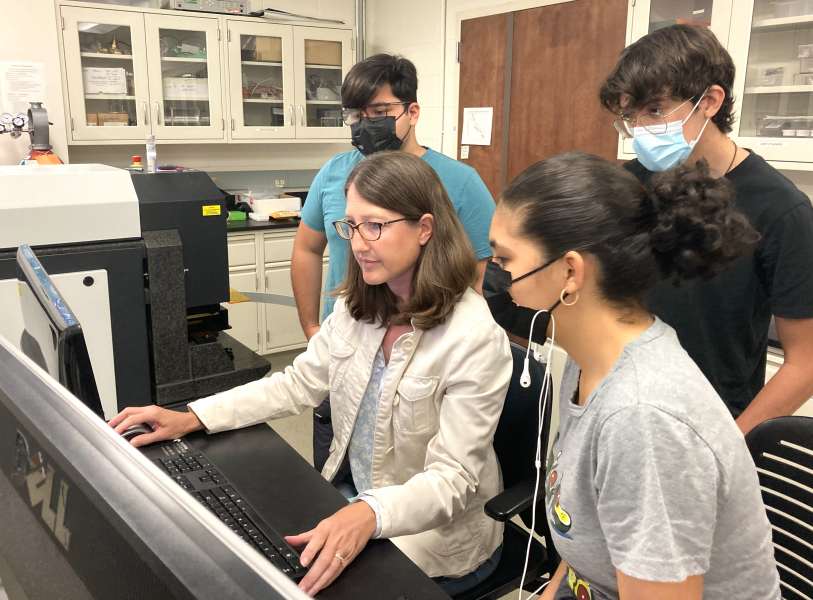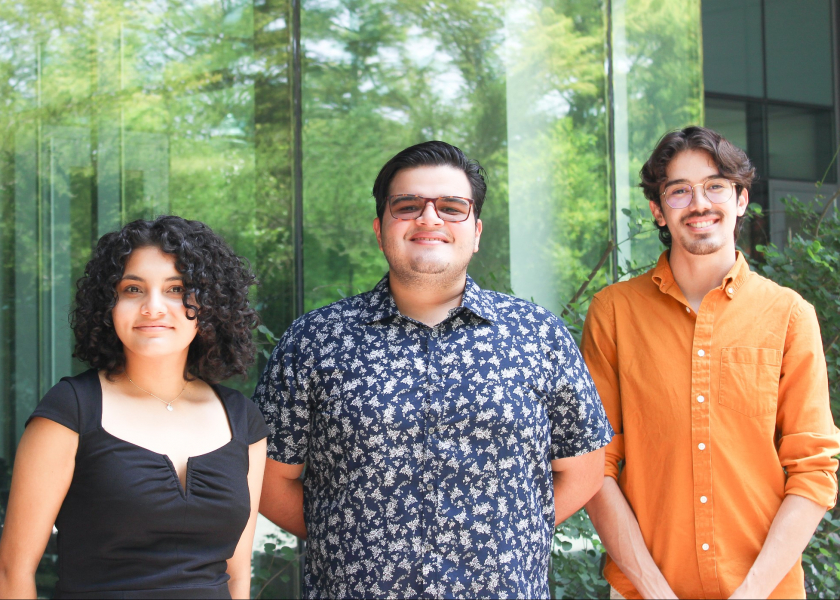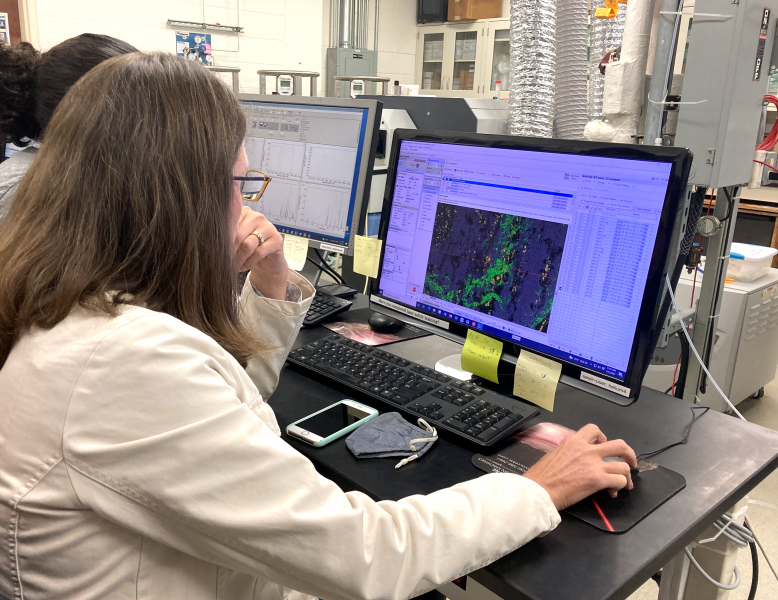Collision & Subduction: High Tech Intro to Geochronology for Puerto Rican Undergraduates
April 15, 2022
The room is large, white, and humming. Gigantic silver ductwork — illuminated by a southern exposure — hangs from the ceiling of the Jackson School of Geosciences’ (JSG) UT Chron Lab, providing breathing room for a space crammed with mass spectrometers, canisters of gas, and technical equipment.
At a smooth, black workbench that bisects the room, a trio of undergraduate interns hover behind Laboratory Manager Lisa Stockli, each staring at a grainy gray image magnified on a computer screen. The pattern of splotches shifts as Lisa’s slender fingers manipulate the mouse to focus in on different parts of the thin section, a slice of a 45-million year old schist from Antarctica recently prepared for analysis.

Suddenly, a patch of fluorescent yellow and green rolls into view. This is what the team is hunting for: brightly colored pixels that pop from the gray background. Reminiscent of colorful Doppler radar images that signal rainstorms, these vibrant patches highlight specific elements incorporated in the rock that can be used to accurately date important events in geological history.
The interns, all juniors at Recinto Universitario de Mayagüez in Puerto Rico, are in Austin for the summer to participate in the Helium Latinx Internship and Outreach Program (HeLIO). HeLIO is the brainchild of faculty member and departmental chair Danny Stockli who, thanks to several grants from the National Science Foundation, has provided summer research opportunities to roughly 25 Puerto Rican geoscience students since the program’s inception in 2009. Each intern is a top scholar nominated by their university’s geology faculty, and, this year, HeLIO will introduce three new undergraduates to the breadth of geological dating by combining research on the Antarctic subduction zone with other projects from around the world.
“For more than a decade, we’ve been building a pipeline for young Puerto Rican scientists by providing them with a real research experience—one with setbacks and complications as well as successes — that allows them to learn cutting-edge analytical methods in the lab,” says Danny Stockli. “Most interns have gone on to geological careers, either through graduate school or with geological agencies.”
Collision in the Field

The 2021 summer internships of Kiara Cunillera-Cotte, Adriel Gonzalez-Rivera, and Fernando Pagan-Gonzalez started with a bit of a bang. Because Austin was in the midst of the COVID pandemic, permissions for an in-person internship in the field and labs came mere weeks before their arrival in Austin.
“It was a fire-drill to make the 2021 internships happen,” says Danny Stockli. “Many people on campus, especially Dana Thomas who coordinates JSG’s fabulous RTX summer undergraduate research, really helped out with logistical support and with arranging housing on campus—all very quickly!”
In addition to Thomas, the UTChron team pulled together a synthetic plate tectonics research project that included local rocks from the Llano Uplift as well as the exotic components from Antarctica. Several of Stockli’s graduate students helped mentor the interns, teaching them research components like thin section microscopy and mineral separation.

After settling in, the trio first headed west near Fredericksburg for a short stint of field work in the stifling Texas summer heat among some of the oldest rocks in Texas—rocks that were formed when life on Earth was confined to the sea. Sharon Mosher, Dean Emeritus of JSG, helped the group gain access to one of her research spots known as Crab Apple Creek. There, the students documented magma cross-cutting relationships and collected samples from different intrusions that developed during an ancient collision event, forming super continent Rodinia.
Back on campus, Kiara, Adriel and Fernando sawed, crushed, and ground their samples to both make thin sections and separate out minerals and zircon crystals for dating. Subsequent work — with the help of Lisa Stockli — used the zircon mineral grains to detail an absolute timeframe for the deformation and magmatism in this part of the Llano Uplift more than a billion years ago.
“From Recinto Universitario de Mayagüez, we already have done lots of field work and knew the basics,” begins Adriel.
Kiara finishes the thought. “But we got to see more in depth and with different equipment while at UT!”
All of the students think that the practical, experiential education that they received over the two months at UT was transformative. The summer research has expanded their knowledge of the possibilities in the Geosciences, and all are now excited about the opportunities in geochemistry and mineralogy.
“This internship helped me realize that I want a career in the Geosciences and am interested in graduate school,” says Fernando. “Interacting with graduate students and other researchers helped clear up any doubts that I had.”
Kiara agrees. “The program opened my eyes and made me look forward to what might have in the future.”
Lasers in the Lab
Back in the large, white lab, the hunt for brightly tagged elements in a field of gray continues. For this to occur, each intern processed a rock collected by the famous faculty member Ian Dalziel from different islands in the Southern Ocean of Antarctica: Elephant, Diego Ramirez, or Smith. After shaving down their samples to the width of a human hair to make thin sections, Kiara, Adriel and Fernando are now searching for clues that narrate the story of how and when oceanic crust was subducted under the Antarctic plate.
First coupling the vivid mineral maps with a “live” image of a sample, their mentor Lisa Stockli looks for a promising section of the sample where the fluorescent signal indicates the presence of minerals like apatite, titanite, or zircon. Each of these minerals can contain uranium, and the decay of that element is used to date the samples.

“I’m going to shoot six quick bursts with the laser, and we will see if we have enough of a signal,” she explains.
Several rapid, rodent-like squeaks come from an intimidating piece of equipment nearby. The technique, called Laser Ablation Inductively Coupled Plasma Mass Spectrometry (LA-ICP-MS), uses a pulse of laser light to excavate fine particles from the surface of a thin section. Then, the constituent elements—including uranium — can be analyzed by the mass spectrometer nearby. This is why, after each burst from the laser, Lisa and the three interns swivel left to a different computer monitor that displays the analysis of the elements.
For most analyses from the mass spectrometer, the team expresses disappointment. It is not easy to find the necessary amount and composition of minerals “in situ.” Imagine shrinking to a pinprick and skidding across the vast distances of a thin section: any lilliputian from story or film would be hard pressed to navigate this landscape for the perfect outcrop or pattern. Finding the right signal or element takes time, experience, and patience.
Lisa Stockli gets up, offering her spot to Kiara so that she can search the thin section and use the equipment. “Let’s turn the energy down and try again,” she says, while everyone discusses possible solutions and suggests where to hunt next. Eventually, the answer is found: the rocks from the Southern Ocean’s islands date to over 44 million years ago. This geological time period is during the demise of the subduction zone when the seaway between South America and Antarctica opened, ultimately leading to the latter continent’s glaciation.
“The results from this summer’s research is really new and jives very well with global climatic models,” says Danny Stockli. “It was not always smooth sailing for the interns during this pandemic summer, but they were fantastic and got to do real, meaningful research — interpreting data, dealing with different people, rolling with problems, working with giants in the field like Mosher and Dalziel. This summer will serve all of them very well.”
Written by Kristin Phillips, Department of Geological Sciences, Jackson School of Geosciences